Hydrothermal circulation in its most general sense is the circulation of hot water. Hydrothermal circulation occurs most often in the vicinity of sources of heat within the Earth's crust. In general, this occurs near volcanic activity, but can occur in the shallow to mid crust along deeply penetrating fault irregularities or in the deep crust related to the intrusion of granite, or as the result of orogeny or metamorphism. Hydrothermal circulation often results in hydrothermal mineral deposits.
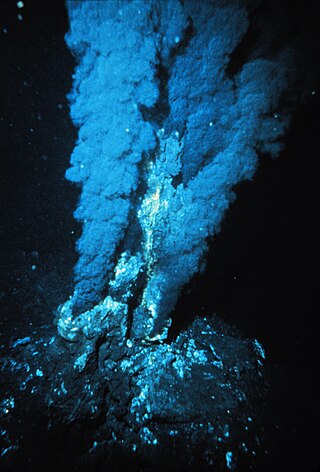
Hydrothermal vents are fissures on the seabed from which geothermally heated water discharges. They are commonly found near volcanically active places, areas where tectonic plates are moving apart at mid-ocean ridges, ocean basins, and hotspots. Hydrothermal deposits are rocks and mineral ore deposits formed by the action of hydrothermal vents.

The seabed is the bottom of the ocean. All floors of the ocean are known as 'seabeds'.
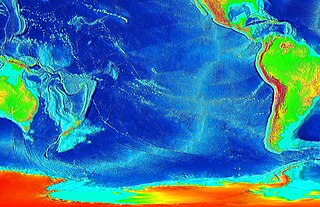
The East Pacific Rise (EPR) is a mid-ocean rise, at a divergent tectonic plate boundary, located along the floor of the Pacific Ocean. It separates the Pacific Plate to the west from the North American Plate, the Rivera Plate, the Cocos Plate, the Nazca Plate, and the Antarctic Plate. It runs south from the Gulf of California in the Salton Sea basin in Southern California to a point near 55°S130°W, where it joins the Pacific-Antarctic Ridge (PAR) trending west-southwest towards Antarctica, near New Zealand. Much of the rise lies about 3,200 km (2,000 mi) off the South American coast and rises about 1,800–2,700 m (5,900–8,900 ft) above the surrounding seafloor.
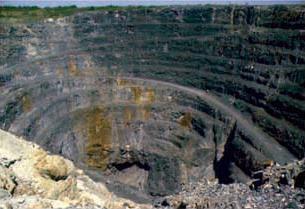
Volcanogenic massive sulfide ore deposits, also known as VMS ore deposits, are a type of metal sulfide ore deposit, mainly copper-zinc which are associated with and created by volcanic-associated hydrothermal events in submarine environments.
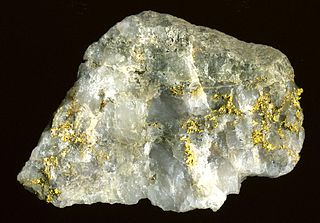
Various theories of ore genesis explain how the various types of mineral deposits form within Earth's crust. Ore-genesis theories vary depending on the mineral or commodity examined.

Sedimentary exhalative deposits are zinc-lead deposits originally interpreted to have been formed by discharge of metal-bearing basinal fluids onto the seafloor resulting in the precipitation of mainly stratiform ore, often with thin laminations of sulphide minerals. SEDEX deposits are hosted largely by clastic rocks deposited in intracontinental rifts or failed rift basins and passive continental margins. Since these ore deposits frequently form massive sulfide lenses, they are also named sediment-hosted massive sulfide (SHMS) deposits, as opposed to volcanic-hosted massive sulfide (VHMS) deposits. The sedimentary appearance of the thin laminations led to early interpretations that the deposits formed exclusively or mainly by exhalative processes onto the seafloor, hence the term SEDEX. However, recent study of numerous deposits indicates that shallow subsurface replacement is also an important process, in several deposits the predominant one, with only local if any exhalations onto the seafloor. For this reason, some authors prefer the term "Clastic-dominated zinc-lead deposits". As used today, therefore, the term SEDEX is not to be taken to mean that hydrothermal fluids actually vented into the overlying water column, although this may have occurred in some cases.
Subsea technology involves fully submerged ocean equipment, operations, or applications, especially when some distance offshore, in deep ocean waters, or on the seabed. The term subsea is frequently used in connection with oceanography, marine or ocean engineering, ocean exploration, remotely operated vehicle (ROVs) autonomous underwater vehicles (AUVs), submarine communications or power cables, seafloor mineral mining, oil and gas, and offshore wind power.
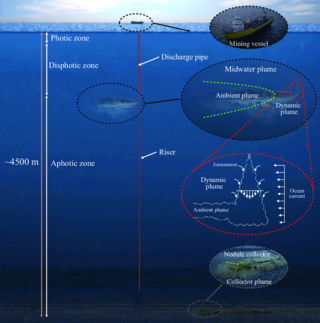
Deep sea mining is the extraction of minerals from the ocean floor found at depths of 200 metres (660 ft) to 6,500 metres (21,300 ft). As of 2021, the majority of marine mining efforts were limited to shallow coastal waters, where sand, tin and diamonds are more readily accessible. It is a growing subfield of experimental seabed mining. Three types of deep sea mining have generated interest: polymetallic nodule mining, polymetallic sulfide mining, and cobalt-rich ferromanganese crusts. The majority of proposed deep sea mining sites are near polymetallic nodules or active and extinct hydrothermal vents at 1,400 to 3,700 metres depth. The vents create globular or "massive" sulfide deposits that contain valuable metals such as silver, gold, copper, manganese, cobalt, and zinc. The deposits are mined using hydraulic pumps or bucket systems that carry ore to the surface for processing.

Loki's Castle is a field of five active hydrothermal vents in the mid-Atlantic Ocean, located at 73 degrees north on the Mid-Atlantic Ridge between Iceland and Svalbard at a depth of 2,352 metres (7,717 ft). They were the most northerly black smoker vents when they were discovered in mid-July 2008.

The Endeavour Hydrothermal Vents are a group of hydrothermal vents in the north-eastern Pacific Ocean, located 260 kilometres (160 mi) southwest of Vancouver Island, British Columbia, Canada. The vent field lies 2,250 metres (7,380 ft) below sea level on the northern Endeavour segment of the Juan de Fuca Ridge. In 1982, dredged sulfide samples were recovered from the area covered in small tube worms and prompted a return to the vent field in August 1984, where the active vent field was confirmed by HOV Alvin on leg 10 of cruise AII-112.

The Beebe Hydrothermal Vent Field is located just south of Grand Cayman in the Caribbean, on the north side of the Mid-Cayman Spreading Centre in the Cayman Trough. Approximately 24 kilometres (15 mi) south of Beebe is the Von Damm Vent Field.
Hydrothermal mineral deposits are accumulations of valuable minerals which formed from hot waters circulating in Earth's crust through fractures. They eventually create metallic-rich fluids concentrated in a selected volume of rock, which become supersaturated and then precipitate ore minerals. In some occurrences, minerals can be extracted for a profit by mining. Discovery of mineral deposits consumes considerable time and resources and only about one in every one thousand prospects explored by companies are eventually developed into a mine. A mineral deposit is any geologically significant concentration of an economically useful rock or mineral present in a specified area. The presence of a known but unexploited mineral deposit implies a lack of evidence for profitable extraction.

Vailuluʻu is a volcanic seamount discovered in 1975. It rises from the sea floor to a depth of 593 m (1,946 ft) and is located between Taʻu and Rose islands at the eastern end of the Samoa hotspot chain. The basaltic seamount is considered to mark the current location of the Samoa hotspot. The summit of Vailuluʻu contains a 2 km wide, 400 m deep oval-shaped caldera. Two principal rift zones extend east and west from the summit, parallel to the trend of the Samoan hotspot. A third less prominent rift extends southeast of the summit.
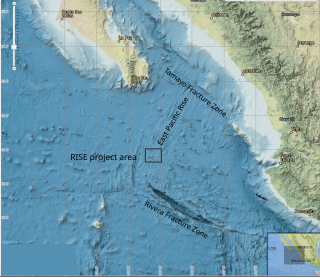
The RISE Project (Rivera Submersible Experiments) was a 1979 international marine research project which mapped and investigated seafloor spreading in the Pacific Ocean, at the crest of the East Pacific Rise (EPR) at 21° north latitude. Using a deep sea submersible (ALVIN) to search for hydrothermal activity at depths around 2600 meters, the project discovered a series of vents emitting dark mineral particles at extremely high temperatures which gave rise to the popular name, "black smokers". Biologic communities found at 21° N vents, based on chemosynthesis and similar to those found at the Galapagos spreading center, established that these communities are not unique. Discovery of a deep-sea ecosystem not based on sunlight spurred theories of the origin of life on Earth.
Kemp Caldera and Kemp Seamount form a submarine volcano south of the South Sandwich Islands, in a region where several seamounts are located. The seamount rises to a depth of 80 metres (260 ft) below sea level; the caldera has a diameter of 8.3 by 6.5 kilometres and reaches a depth of 1,600 metres (5,200 ft). The caldera contains several Hydrothermal vents, including white smokers and diffuse venting areas, which are host to chemolithotrophic ecological communities. The seamount and caldera, which were discovered by seafloor mapping in 2009, are part of the South Georgia and the South Sandwich Islands Marine Protected Area.
Seabed mining, also known as Seafloor mining is the recovery of minerals from the seabed by techniques of underwater mining. The concept includes mining at shallow depths on the continental shelf and deep-sea mining at greater depths associated with tectonic activity, hydrothermal vents and the abyssal plains. While there is opportunity for economical mineral extraction at areas of high concentration of valuable minerals, there is also significant risk of ecological damage of unknown and to some degree, unpredictable, extent. Increasing requirements for minerals and metals, largely for use in the technology sector, has led to renewed interest in exploitation of seabed mineral resources, including massive polymetallic sulfide deposits around hydrothermal vents, cobalt-rich crusts on the sides of seamounts and fields of manganese nodules on the abyssal plains.
Massive sulfide deposits are ore deposits that have significant stratiform ore bodies consisting mainly of sulfide minerals. Most massive sulfide ore deposits have other portions that are not massive, including stringer or feeder zones beneath the massive parts that mostly consist of crosscutting veins and veinlets of sulfides in a matrix of pervasively altered host rock and gangue.
Rachel Haymon is a marine geologist known for her work linking geological and biological processes occurring at deep-sea hydrothermal vents. In 2005 she was elected a fellow of the Geological Society of America.
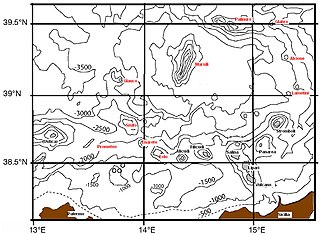
Palinuro Seamount is a seamount in the Tyrrhenian Sea. It is an elongated 50–70 km (31–43 mi) long complex of volcanoes north of the Aeolian Islands with multiple potential calderas. The shallowest point lies at 80–70 m (260–230 ft) depth and formed an island during past episodes of low sea level. Palinuro was active during the last 800,000 years and is likely the source for a 10,000 years old tephra layer in Italy. Ongoing seismicity occurs at the seamount, which may be a tsunami hazard. The volcanic activity may somehow relate to the subduction of the Ionian Sea farther east.













